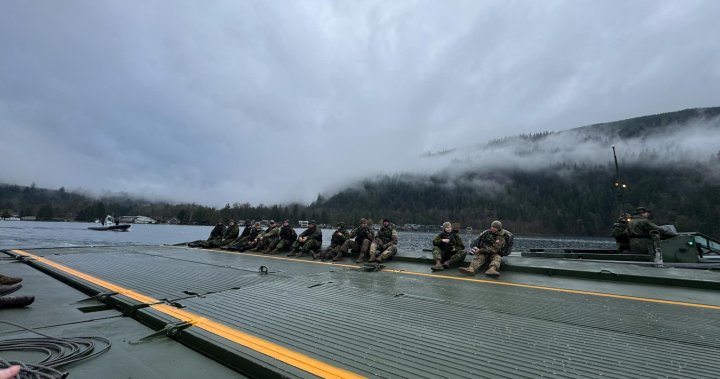Paragraph 1: Exercise Paladin Response: A Crucible for Disaster Relief Training
The Canadian Armed Forces (CAF) has initiated Exercise Paladin Response, an annual training exercise focused on honing the disaster relief capabilities of its reservists. Held in Chilliwack, British Columbia, this intensive program brings together approximately 200 combat engineer reservists from across Canada, representing units from Newfoundland to British Columbia. The exercise also incorporates members of the U.S. Army from Washington and Oregon, fostering international collaboration and interoperability in disaster response scenarios. This collaborative approach underscores the importance of shared knowledge and coordinated efforts in addressing large-scale emergencies that may transcend national borders. The training concentrates on enhancing the reservists’ skills in the critical areas of bridge construction, raft assembly, and watercraft operation, all essential for providing aid and access in disaster-stricken regions.
Paragraph 2: Bridging the Gap: Engineering Expertise in Action
A central component of Exercise Paladin Response revolves around bridge construction, equipping reservists with the expertise to establish vital lines of communication and transportation in disaster-affected areas. The training encompasses the construction of two primary bridge types: medium girder bridges (MGBs) and prefabricated modular steel Acrow bridges. MGBs serve as temporary solutions, rapidly deployed to enable troop and vehicle movement across obstacles, while the more robust Acrow bridges provide longer-term, heavy-duty logistical support. The distinction in their application highlights the adaptability and versatility required in disaster response, where infrastructure needs can vary drastically depending on the nature and duration of the emergency. This training ensures reservists can select and implement the appropriate bridging solution based on the specific challenges presented by a given situation.
Paragraph 3: Navigating the Waters: Amphibious Operations for Rescue and Relief
Beyond bridge construction, Exercise Paladin Response incorporates training in amphibious operations, crucial for reaching communities isolated by floods or other natural disasters. Reservists practice operating assault boats and assembling medium floating rafts (PMRs) on Cultus Lake. These PMRs are designed to transport vehicles, troops, and essential supplies across waterlogged terrain, enabling access to areas cut off by conventional transportation routes. This aspect of the training equips reservists with the skills to navigate challenging aquatic environments and deliver critical aid to affected populations, underscoring the multifaceted nature of disaster response and the need for adaptable, multi-skilled personnel.
Paragraph 4: The Reserve Force: A Vital Component of Domestic Disaster Response
The reservists participating in Exercise Paladin Response represent a crucial element of Canada’s domestic disaster response capabilities. These individuals primarily serve in part-time positions, balancing their military commitments with civilian careers or post-secondary education. Their dedication to serving their communities and country highlights the vital role of the Reserve Force in supporting emergency operations. Combat engineers, in particular, play a crucial role in providing mobility support to the army, ensuring access to disaster-stricken areas and facilitating the delivery of aid and resources. This dual role, balancing civilian life with military service, demonstrates the adaptability and commitment of reservists in contributing to national security and disaster preparedness.
Paragraph 5: Operation LENTUS: A Framework for Domestic Disaster Assistance
The training received during Exercise Paladin Response directly contributes to the reservists’ preparedness for Operation LENTUS, the Canadian Armed Forces’ framework for providing assistance to provincial and territorial authorities during domestic emergencies. Operation LENTUS has been activated regularly in recent years, reflecting the increasing frequency and severity of natural disasters across Canada. The reservists’ ability to rapidly deploy and provide specialized engineering support, such as bridge construction and watercraft operation, becomes invaluable in these situations, enabling the swift and effective delivery of aid to affected communities. Exercise Paladin Response serves as a vital training ground, ensuring reservists are equipped with the skills and experience necessary to effectively contribute to Operation LENTUS when called upon.
Paragraph 6: Preparing for the Call: A Commitment to Service and Readiness
As Exercise Paladin Response concludes on New Year’s Eve, the reservists return to their civilian lives, carrying with them the enhanced skills and knowledge gained during this intensive training period. They remain on standby, ready to be mobilized when their expertise is needed most, whether in response to natural disasters, humanitarian crises, or other emergencies. Their commitment to service and preparedness exemplifies the crucial role of the Reserve Force in ensuring Canada’s ability to effectively respond to a wide range of challenges, both at home and abroad. This dedication reflects a spirit of civic duty and a willingness to contribute to the safety and well-being of their communities and the nation as a whole.

